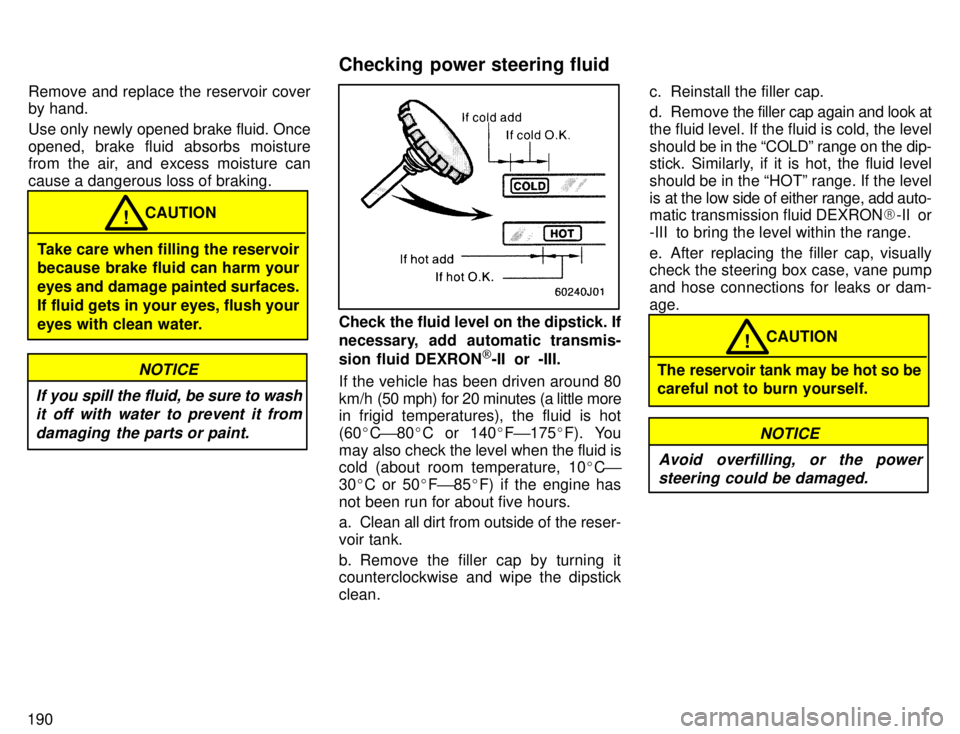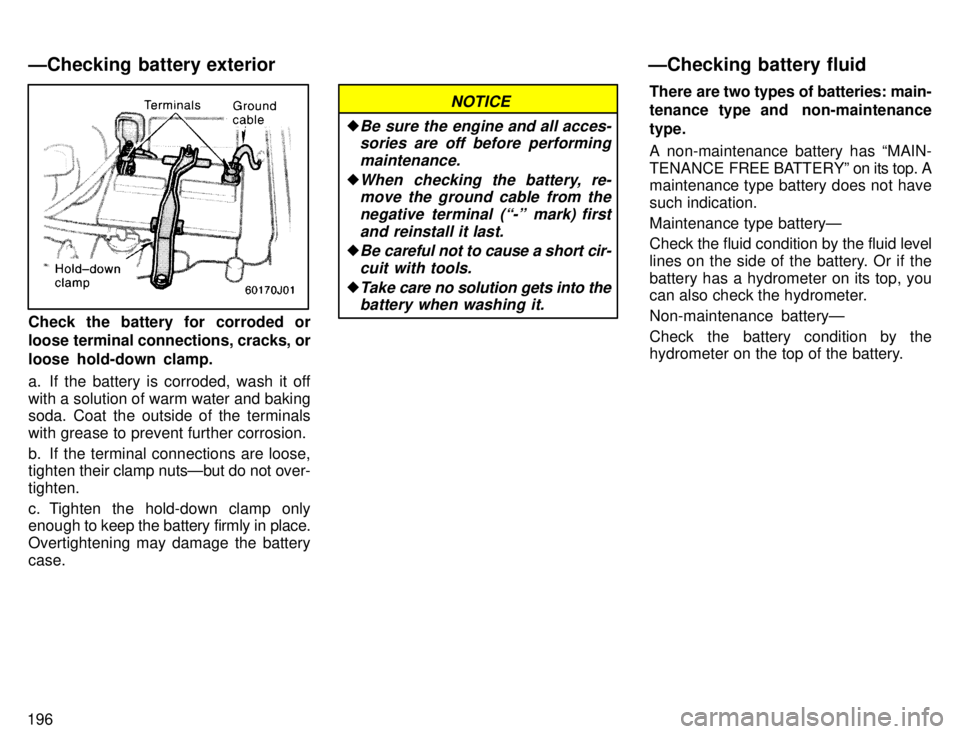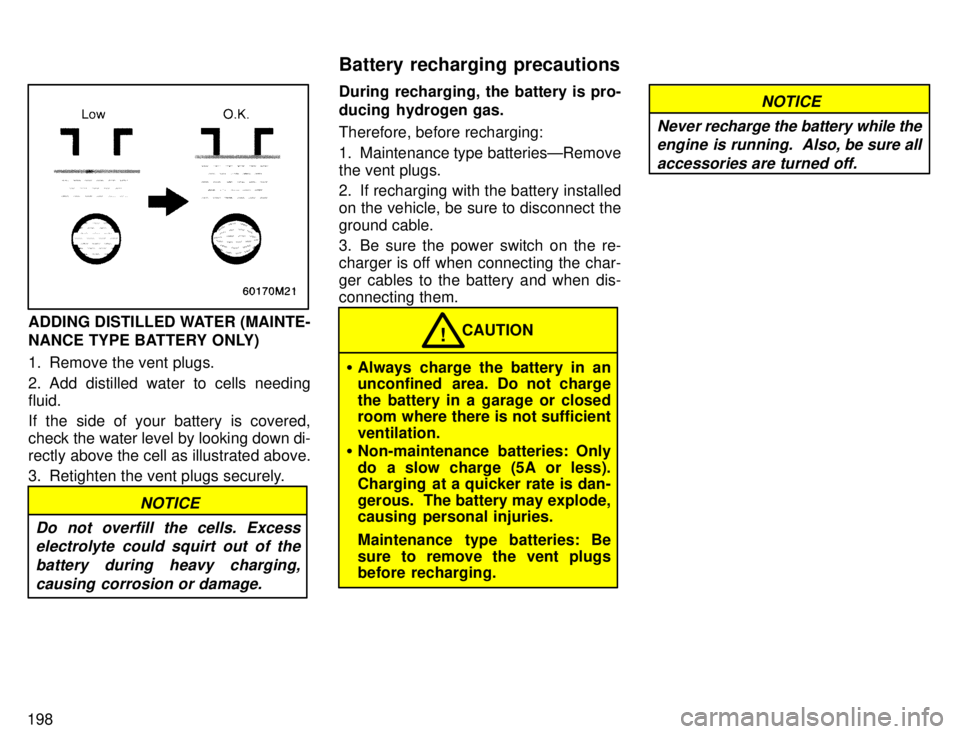Page 193 of 217

190Remove and replace the reservoir cover by hand. Use only newly opened brake fluid. Once
opened, brake fluid absorbs moisture
from the air, and excess moisture can cause a dangerous loss of braking.
CAUTION!
Take care when filling the reservoir
because brake fluid can harm your
eyes and damage painted surfaces.If fluid gets in your eyes, flush your
eyes with clean water.
NOTICE
If you spill the fluid, be sure to wash it off with water to prevent it from
damaging the parts or paint.
Check the fluid level on the dipstick. If
necessary, add automatic transmis-
sion fluid DEXRON [
-II or -III.
If the vehicle has been driven around 80
km/h (50 mph) for 20 minutes (a little more
in frigid temperatures), the fluid is hot(60 �C ' 80 �C or 140 �F ' 175 �F). You
may also check the level when the fluid is
cold (about room temperature, 10 �C '
30 �C or 50 �F ' 85 �F) if the engine has
not been run for about five hours.
a. Clean all dirt from outside of the reser- voir tank.
b. Remove the filler cap by turning it
counterclockwise and wipe the dipstick clean. c. Reinstall the filler cap.
d. Remove
the filler cap again and look at
the fluid level. If the fluid is cold, the level
should be in the COLDº range on the dip-
stick. Similarly, if it is hot, the fluid level
should be in the HOTº range. If the level
is at the low side of either range, add auto-
matic transmission fluid DEXRON �-II or
-III to bring the level within the range.
e. After replacing the filler cap, visually check the steering box case, vane pump
and hose connections for leaks or dam-age.CAUTION!
The reservoir tank may be hot so be
careful not to burn yourself.
NOTICE
Avoid overfilling, or the power steering could be damaged.
Checking power steering fluid
Page 199 of 217

196
Check the battery for corroded or
loose terminal connections, cracks, or
loose hold-down clamp.
a. If the battery is corroded, wash it off with a solution of warm water and baking
soda. Coat the outside of the terminals with grease to prevent further corrosion.
b. If the terminal connections are loose, tighten their clamp nutsÐbut do not over-
tighten.
c. Tighten the hold-down clamp only
enough to keep the battery firmly in place.
Overtightening may damage the battery case.
NOTICE
�Be sure the engine and all acces-
sories are off before performing
maintenance.
�When checking the battery, re-move the ground cable from the
negative terminal (-º mark) first
and reinstall it last.
�Be careful not to cause a short cir-cuit with tools.
�Take care no solution gets into thebattery when washing it.
There are two types of batteries: main-
tenance type and non-maintenance type. A non-maintenance battery has MAIN-
TENANCE FREE BATTERYº on its top. A
maintenance type battery does not havesuch indication. Maintenance type batteryÐ Check the fluid condition by the fluid level
lines on the side of the battery. Or if the
battery has a hydrometer on its top, you
can also check the hydrometer. Non-maintenance batteryÐ
Check the battery condition by the
hydrometer on the top of the battery.
ÐChecking battery exterior
ÐChecking battery fluid
Page 201 of 217

198
ADDING DISTILLED WATER (MAINTE-
NANCE TYPE BATTERY ONLY)
1. Remove the vent plugs.
2. Add distilled water to cells needing fluid.
If the side of your battery is covered,
check the water level by looking down di-
rectly above the cell as illustrated above.
3. Retighten the vent plugs securely.
NOTICE
Do not overfill the cells. Excess electrolyte could squirt out of the
battery during heavy charging,causing corrosion or damage.
During recharging, the battery is pro-
ducing hydrogen gas. Therefore, before recharging:
1. Maintenance type batteriesÐRemove the vent plugs.
2. If recharging with the battery installed on the vehicle, be sure to disconnect theground cable.
3. Be sure the power switch on the re-
charger is off when connecting the char-ger cables to the battery and when dis-
connecting them.
� Always charge the battery in an
unconfined area. Do not charge
the battery in a garage or closed
room where there is not sufficient ventilation.
� Non-maintenance batteries: Only
do a slow charge (5A or less).
Charging at a quicker rate is dan-
gerous. The battery may explode,
causing personal injuries.
Maintenance type batteries: Be sure to remove the vent plugs
before recharging.
CAUTION!
NOTICE
Never recharge the battery while the
engine is running. Also, be sure all
accessories are turned off.
Battery recharging precautions
Page 210 of 217

+20 -15207
5VZ-FE engine
Generator belt 100 + 20
Air conditioning compressor belt 100 + 20
Power steering
pump belt 100
ENGINE LUBRICATION
Oil capacity (drain and refill), L (qt., Imp. qt.): 3RZ-FE engine With filter 5.4 (5.7, 4.8)
Without filter 4.7 (5.0, 4.1)
5VZ-FE engine With filter 5.2 (5.5, 4.6)
Without filter 4.9 (5.2, 4.3) Oil grade:
API SH, Energy-Conserving IIº multi-
grade engine oil or ILSAC multigrade
engine oil is recommended.
Recommended oil viscosity (SAE):
COOLING SYSTEM
Total capacity, L (qt., Imp. qt.): 3RZ-FE engine
With rear heater 11.0 (11.6, 9.7)
Without rear heater
10.0 (10.6, 8.8)
5VZ-FE engine With rear heater
9.0 (9.5, 7.9)
Without rear heater 8.0 (8.5, 7.0) Coolant type:
With ethylene-glycol antifreeze (Do not use alcohol type.)
BATTERY ÐMaintenance type battery Specific gravity reading at 20 �C (68 �F):
1.280 Fully charged
1.180 Half charged
1.080 Discharged
ÐNon-maintenance battery Open voltage* at 20 �C (68 �F):
12.7 V Fully charged
12.3 V Half charged
11.9 V Discharged
*: Voltage that is checked 20 minutes af-
ter the key is removed with all the lights
turned off
Charging rates: Non-maintenance battery 5 A max. Maintenance type batteryQuick charge 15 A max.
Slow charge 5 A max.
CLUTCH
Pedal freeplay, mm (in.):
5Ð15 (0.2Ð0.6)
Fluid type:
SAE J1703 or FMVSS No. 116 DOT 3